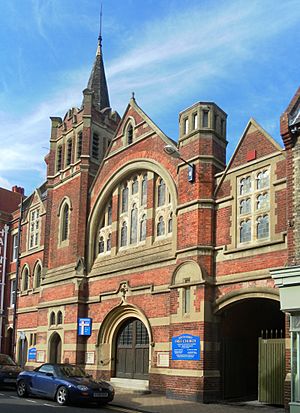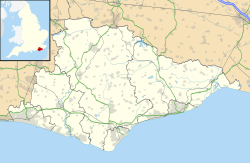South Street Free Church, Eastbourne facts for kids
Quick facts for kids South Street Free Church |
|
|---|---|

The church from the southeast
|
|
| 50°46′00″N 0°16′46″E / 50.766533°N 0.279548°E | |
| Location | 21 South Street, Eastbourne, East Sussex BN21 4UP |
| Country | England |
| Denomination | Countess of Huntingdon's Connexion |
| Previous denomination | Congregational |
| History | |
| Status | Church |
| Founded | 1897 |
| Founder(s) | Reverend George Thompson |
| Architecture | |
| Functional status | Active |
| Heritage designation | Grade II |
| Designated | 8 May 2009 |
| Architect(s) | Henry Ward |
| Style | Arts and Crafts |
| Years built | 1903 |
| Groundbreaking | 6 May 1903 |
| Completed | 1904 |
South Street Free Church is a special church in the middle of Eastbourne. This is a town by the sea in the English county of East Sussex. It started as a Congregational church. Now, it's part of the Countess of Huntingdon's Connexion. This is a small group of Christian churches. They follow the teachings of Selina Hastings, Countess of Huntingdon. She lived in the 1700s during a time of Christian revival.
The church was founded in 1897. It was an offshoot from an older Congregational chapel. At first, the church met in rented places. A local architect named Henry Ward designed the current church in 1903. This building has a unique Arts and Crafts style. It is considered important for its history and design. Because of this, it has been given a special Grade II listing by Historic England.
Contents
History
How the Church Started
A Congregational church was built in Eastbourne in 1862. In 1897, some members decided to start a new church. They first met in a building on Saffrons Road. This building used to be an Anglican church. It was built in 1878.
The building was later bought by Eastbourne Council. It was renamed Grove Hall. The council rented it to the new church. Reverend George Thompson was chosen as the first pastor.
Building the New Church
The church members wanted their own permanent building. In 1903, they asked local architect Henry Ward to design a church. The new church would be on South Street. This was close to their rented building. The land used to be a blacksmith's workshop.
The first stone of the church was laid on May 6, 1903. Reverend Thompson laid the stone. It showed the names of Henry Ward, the architect, and the builders. The church members moved into the new building in 1904. At first, it was called the New Congregational Church.
Joining a New Group
Reverend George Thompson retired in 1907. After some time, Reverend J. Westbury Jones became the minister in 1914. At the same time, the church joined the Countess of Huntingdon's Connexion. This group was started by Selina Hastings, Countess of Huntingdon in the 1700s.
She was born in 1707. She became interested in Methodist ideas. Later, she was influenced by the preacher George Whitefield. She then moved towards Calvinistic teachings. In 1783, she officially started her Connexion. This group was, and still is, Evangelical.
Later Years
In 1918, Reverend Frederick Hastings became the minister. He served the church in Eastbourne until he passed away in 1937. He was 98 years old. The church then closed during World War II. The building became damaged.
After the war, the building was repaired. More people joined the church under new ministers. The current pastor, David Batchelor, started in October 2010. He joined after finishing his studies at Oak Hill Theological College.
Architecture and Design
Henry Ward was the architect who designed the church. He moved from London to Hastings in the 1870s. He designed many buildings in the area.
Church Style
South Street Free Church was designed in a strong Arts and Crafts style. It also has parts of Gothic Revival architecture. It's described as "Free Gothic." This means it doesn't exactly match one old style.
The building is made of red brick. It has stone details and horizontal bands. The windows have stone frames. The front of the church looks "quirky" and "busy." It is not perfectly even. It has five sections of different widths and heights.
On the left, there is a narrow section. It looks like a house. It has a small roof point and two small arched windows. Next, there is a short tower with a pointed top. The main entrance is in the middle. It has a wide roof point and windows inside a large round arch. Then there is a short, round tower. On the far right, there is a low section with windows like the left side. The tower helps the church stand out on the narrow street.
Inside the Church
Inside, the main area is called the nave. It has five sections. There are arches on both sides that hold up a balcony. This balcony goes around three sides of the church. The original organ and pulpit have been changed. But the front of the balcony is original. It has special four-leaf clover shapes. The pews and some other parts are also original.
Light comes in through windows high up on the walls. There is a rounded area at the east end of the church. The wooden roof is held up by special arched supports.
Special Status
The church was given a Grade II listing on May 8, 2009. This means it is "nationally important and of special interest." As of February 2021, it was one of 100 Grade II listed buildings in Eastbourne. There were 109 listed buildings of all grades in the area.
Church Activities
The church is officially registered for worship. It was also registered to hold marriages in 1904. As of 2022, it was one of 22 churches in England that are part of the Countess of Huntingdon's Connexion. Many of these churches are in East Sussex and West Sussex.
Morning and evening services are held every Sunday. Two of these services each month include Holy Communion. Prayer meetings happen every Tuesday evening. The church also holds monthly services at four different care homes in the town. A youth group meets weekly at the church. Other regular events include a lunch club for older people. There is also a discussion group open to everyone.
See also
- List of places of worship in Eastbourne
- Listed buildings in Eastbourne


